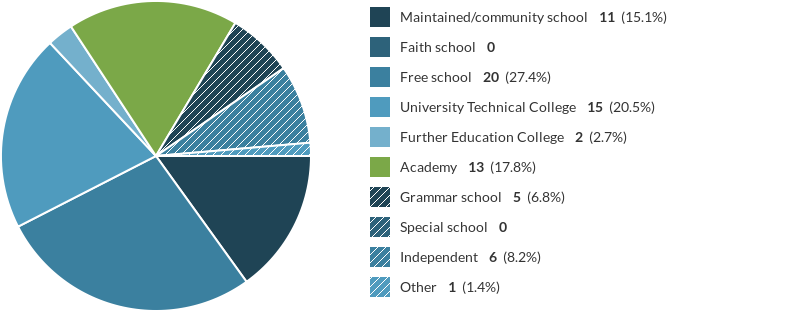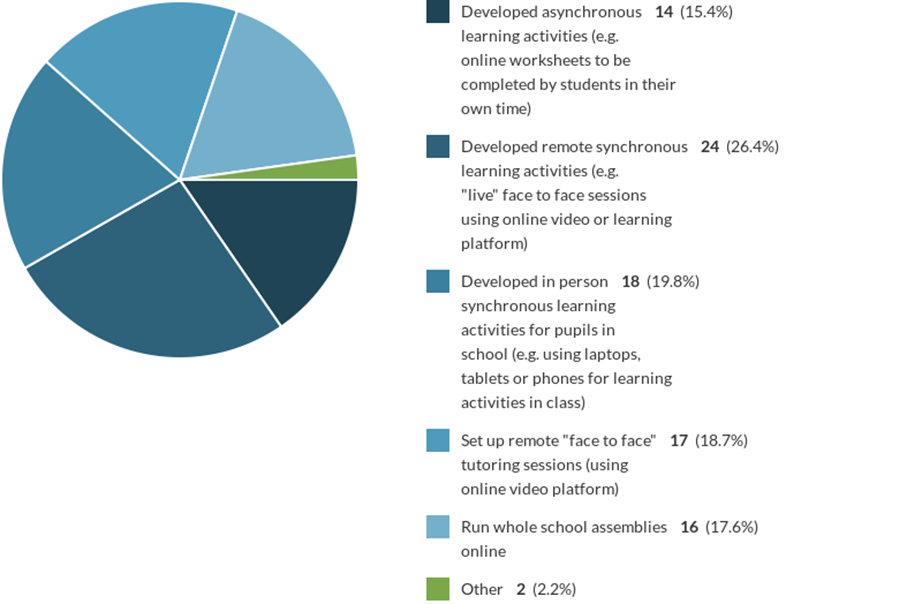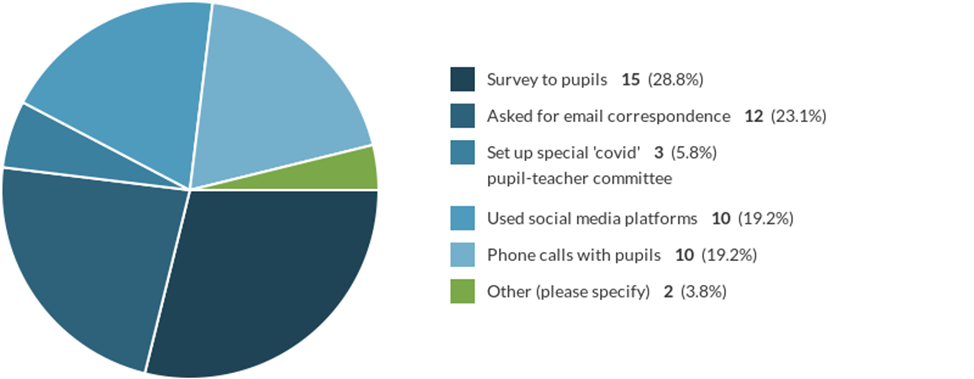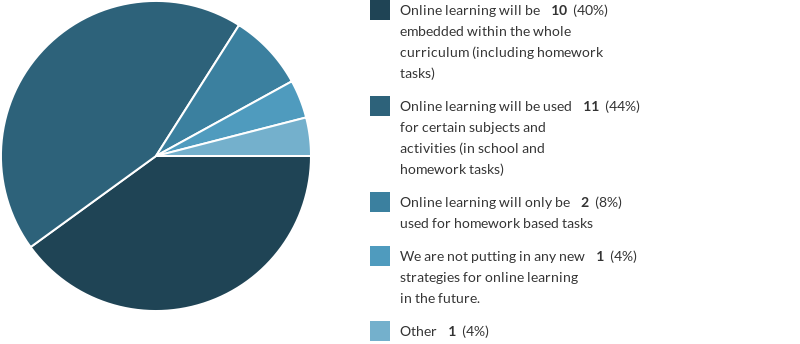You are here
- Home
- Leading school learning through Covid-19 and beyond – initial results from our online survey
Leading school learning through Covid-19 and beyond – initial results from our online survey
Following on from previous posts that outlined the project and highlighted some of the initial qualitative findings, this post outlines initial findings from the survey section of our mixed methods study exploring how school leaders strategically manage and plan for the online provision of learning through the Covid-19 pandemic and beyond.
There are approximately 3500 secondary schools in England, and by the end of the project we are hoping to collect data from 10% of these (n=350).
To achieve this goal, the survey has been distributed to headteachers via a range of routes:
- Direct email via partner databases and networks
- Social media platforms e.g Twitter
- Snowball sampling (passed on from participant to participant)
To date (10th June 2021) we have had 27 surveys completed representing a range of school types (see figure 1).

Figure 1 - School Types
School sizes ranged from 6 which had under 500 pupils (24%) to 3 which had over 1500 pupils (12%) as shown in figure 2.

Figure 2 – School Size
10 of the schools in the sample (40%) had an above average percentage of pupils with SEND on roll as shown in figure 3.

Figure 3 - Percentage of pupils with SEND
For pupils on free school meals, 9 of the 27 schools (36%) were above the national average for this measure (see figure 4).

Figure 4 - Percentage of pupils with FSM
For pupils with EAL, 5 schools (20.8%) were above the national average as shown in figure 5.

Figure 5 – Percentage of pupils with EAL
Initial findings
There are some key issues that are emerging from the survey that will be explored and analysed in more detail as the project continues. These include the following challenges but also several opportunities that have emerged as schools respond to the restrictions with increased innovation and creativity:
Challenges
Prior Knowledge and Experience
Of the 16 schools who said online learning was part of the school curriculum (including homework tasks) before Covid-19 restrictions were introduced, only 6 schools (22.2%) stated that online learning was fully embedded within the whole curriculum (see figure 6). This has implications for the ability of schools to successfully implement online learning quickly, especially during the first lockdown.

Figure 6 – In what way was on-line learning part of your curriculum?
Staff development needs
12 school leaders (48%) indicated that the person responsible for online learning had changed since the introduction of Covid-19 restrictions. The breakdown of who is now responsible is shown in figure 7 and suggests that many schools have distributed this responsibility across several key staff within their schools. While this shows flexibility and collaboration in working practices during the crisis, it has implications for staff development and training for these schools moving forward.

Figure 7 – Who is now responsible for online learning during Covid-19 restrictions?
Indeed, when asked to rank the main challenges of leading on-line learning during Covd-19 restrictions, a lack of staff expertise was again identified as either the number one or second main challenge for 12 of the school leaders (57.1%), with a lack of pupil expertise identified as the main or second ranked key challenge for 10 (50%), and a lack of equipment or available home provision for pupils being identified as the main or second ranked key challenge for 14 (73.7%). Interestingly, behaviour management was only identified as a main or second ranked key challenge for 3 schools (15.8%), with 8 schools (42.1%) ranking this as the least challenging aspect of leading online learning during the restrictions and 3 (15.8%) stating that it was not an issue at all.
Support Required
During Covid-19 restrictions, school leaders identified key aspects of support that would have helped them to be more successful in developing meaningful online learning experiences for their pupils which included which included curriculum support (n=13; 56.5%), hardware (n=10; 43.5%) and software support (n=17; 73.9%), and staff development and guidance (n=16; 69.6%) – see figure 8.

Figure 8 – What support and guidance would have helped during the restrictions
In relation to laptop/hardware provision from the government, 21 schools (87.5%) requested this with only 1 school disappointingly not receiving any of the hardware support they requested. One head gave more details of some of the challenges of getting support in this area in the open comments box:
We received a total of 61 devices, 56 in January 2021 then the remaining 5 in March 2021. More than 96 families had barriers to access - this helped to an extent but was not sufficient. We are still awaiting 4G routers from DfE, although we managed to source some from another school.
Impact on pupils with SEND, EAL, or on FSM
School leaders were asked whether pupils with SEND, with EAL, and on FSM were able to engage fully with online learning provision during Covid-19 restrictions and the results of these questions are shown in figures 9, 10 and 11 respectively. It is clear from these results that while the majority of headteachers felt that pupils in these groups were able to engage fully, there were still a worrying number of school leaders who felt that they had not been able to: 5 (23.8%) for pupils with SEND, 6 (28.6%) for pupils with EAL, and 4 (20%) for pupils on FSMs. These results confirm that Covid-19 restrictions appear to disproportionally negatively affect pupils in these groups in relation to engaging with online learning. As one school leader stated in the open comments box:
The process highlighted the gap between those that have technology access and those that do not. We are working now to ensure that our students can have access to home learning but it is clear that many students struggle to access learning this way and a lot needs to be done at both school but primarily at central gov level to address this divide.

Figure 9 - Pupils with SEND were able to fully engage with online learning provision.

Figure 10 - Pupils with EAL were able to fully engage with online learning provision.

Figure 11 - Pupils on FSMs were able to fully engage with online learning provision.
The majority of schools offered a variety of support for pupils in these groups which included advising them to attend school in person, providing equipment, providing financial support, and offering one to one tutorials and learning support.
Opportunities
Innovation and Creativity
Schools have introduced a range of varied online learning activities during the restrictions, as show in Figure 12.

Figure 12 - Online learning provision implemented during Covid-19 restrictions
And there appears to have been a key ‘step change’ in developing more suitable online learning activities from the first to the second lockdown with all schools (n=27; 100%) having made some key changes to the management of online learning in the period between the first lockdown in March 2020 and the second principal lockdown in the winter of 2020/ 2021 (see figure 13). These changes included developing more suitable online learning activities and ensuring that learners were able to engage more fully with the curriculum. These data highlights some of the institutional growth and development that has emerged in response to the crisis, showing evidence of the pedagogical innovation and creativity that has arisen in an attempt to improve online teaching and learning provision for pupils during the restrictions.

Figure 13 – change in online provision from the first lockdown to the second
Stakeholder Collaboration
Encouragingly, the majority of schools engaged with parents/carers/guardians (n=21, 84%) and pupils (n=20; 83.3%) when developing their online learning provision (as shown in figures 14 and 15) which suggests a more collaborative model of teaching and learning development, than perhaps existed before restrictions were introduced.

Figure 14 – Parent/carer/guardian engagement in developing online learning

Figure 15 – Pupil engagement with developing online learning
Imagined Future Possibilities
When asked what role they thought online learning will play after Covid-19 restrictions are lifted, all the leaders who answered the question thought that it would play either a major or medium role in their institution as shown in figure 16.

Figure 16 – What role will online learning play after restrictions are lifted?
Figure 17 shows the different strategies that school leaders are putting in place for online learning in the future, with 10 (40%) fully embedding online learning within the whole curriculum.

Figure 17 - What strategies are you putting in place in your school for online learning in the future?
When cross tabulated with the schools that did not have any online provision before Covid-19 restrictions were introduced, 7 out of the 9 schools (77.8%) will be implementing some sort of online learning in the future, with all these schools fully embedding it or using it for a range of subjects both in class and for homework tasks. This finding suggests that some school leaders are beginning to imagine future education differently, with many moving towards a more strategic blended learning approach for the teaching and learning provision in their schools.
Next steps
Once we have collected data from a larger number of schools (as reported earlier we are hoping for data from 10% of English secondary schools (n=350)), we will undertake a more thorough analysis of the data, including inferential statistical analysis and hypothesis testing, which will allow for a more detailed picture to emerge as to how school leaders have strategically managed and planned for the online provision of learning through the Covid-19 pandemic and beyond.